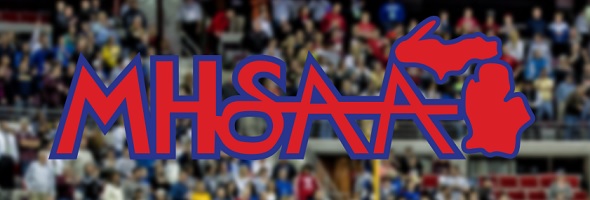
This Week In High School Sports: 1/24/20
January 24, 2020
This week’s show highlights White Pigeon multi-sport standout Claycee West, awards Game Balls to Jonesville's competitive cheer team and Pelllston basketball's Blake Cassidy, clears up misconceptions on basketball goaltending and highlights some of the key points from last weekend's Youth Football Forum.
The 5-minute program, powered by MI Student Aid, leads off each week with feature stories from around the state from the MHSAA’s Second Half or network affiliates. "Be The Referee," a 60-second look at the fine art of officiating, comes in the middle of the show and is followed by a closing MHSAA "Perspective."
Listen to this week's show by Clicking Here.
Past editions
Jan. 17: Promoting and protecting youth football, amateurism in educational athletics - Listen
Jan. 10: Livonia Stevenson hockey's Seth Lause, multi-media and social media impacts - Listen
Dec. 27: Mona Shores "Sailor Nation" life-saving success - Listen
Dec. 20: Battle of the Fans IX, details on purchasing Finals broadcasts - Listen
Dec. 13: Port Huron United hockey, what matters most in high school sports - Listen
Dec. 6: Highlights from 2019 11-Player Football Finals, instant replay in review - Listen
Nov. 29: Highlights from 2019 8-Player Football, Girls Volleyball and Girls Swimming & Diving Finals - Listen
Nov. 22: Ida volleyball record-setter Taylor Wegener, new Football Finals video review - Listen
Nov. 15: Reading lineman Nick Affholter, coaches as leaders in sportsmanship - Listen
Nov. 8: Lower Peninsula Cross Country and Boys Soccer Finals highlights - Listen
Nov. 1: Muskegon Orchard View football, bolstered MHSAA broadcast schedule - Listen
Oct. 25: Grand Rapids NorthPointe Christian girls golf, MHSAA Football Playoff selection - Listen
Oct. 18: Mendon volleyball's title drive, recognition for longtime announcer Erik O. Furseth - Listen
Oct. 11: Negaunee cross country's Emily Paupore, MHSAA mental health awareness efforts - Listen
Oct. 4: South Lyon soccer's Josh Mason, improving youth football - Listen
Sept: 27: Utica Eisenhower golfer Ariel Chang, adult fan behavior - Listen
Sept: 20: Pinckney football inspiration, decisions made at the local level - Listen
Sept. 13: Muskegon's offensive line, soccer substitution rule change - Listen
Sept. 6: Jenison girls golf's inspiration, new football practice contact restrictions - Listen
Aug. 30: St. Johns quarterback-now-coach Andy Schmitt, benefits of a multi-sport experience - Listen

NFHS Voice: Your Best Sports Option
September 18, 2019
By Karissa Niehoff
NFHS Executive Director
Recent articles have documented the rising costs of club sports, with one noting that about 62 percent of “travel ball” parents will go into debt to involve their kids in year-round sports.
A USA Today article in 2017 suggested that travel baseball or volleyball could cost a family upwards of $8,000 a year, with soccer running about $5,000 on the high end. A study by TD Ameritrade suggested some parents were spending about $100 to $500 a month to fund their kids’ participation on a club team, with about 20 percent spending $1,000 a month.
Why? In some cases – unquestionably the minority – students are in the elite category from a skills standpoint and could benefit from a higher level of competition in preparation for college. In most cases, however, it is a case of parents spending beyond their means with the hope that playing club sports will be the difference-maker in their children receiving an athletic scholarship to an NCAA Division I school.
It is, in fact, true that an overwhelming majority of NCAA Division I athletes played club sports. According to an NCAA survey, 92 percent of women and 89 percent of men played club basketball, and 91 percent of women’s volleyball players competed on a non-school team in high school. At the other end, however, only 24 percent of football players competed on a club team.
Herein lies the difference. There are more than 540,000 boys who played high school basketball last year and fewer than 6,000 who played basketball at the NCAA Division I level where most of the scholarships are available. Stated another way, about one percent of high school boys basketball players will play at the NCAA Division I level. About 2.8 percent of the one million-plus boys in high school 11-player football will play at the Division I level.
The answer? Parents should encourage their kids to play multiple sports for their high school teams and save the money they would spend on club sports for college tuition if scholarship money does not materialize. Even in those situations where students are charged a modest fee to participate, school-based sports remain an incredible bargain when compared to club sports.
In many cases, Division I football and basketball coaches are looking to recruit multiple-sport athletes. While there are a few sports where non-school competition is crucial, college coaches will find those athletes who excel in school-based sports.
High school-based sports have more interest, more media coverage and more fans than club sports, and the kids have more fun because they are representing their team and their community.
Playing one sport in the fall, another during the winter and yet another in the spring is the best route to future success – whether that success is on the playing field or court, or in a boardroom.
Dr. Karissa L. Niehoff is beginning her second year as executive director of the National Federation of State High School Associations (NFHS) in Indianapolis, Indiana. She is the first female to head the national leadership organization for high school athletics and performing arts activities and the sixth full-time executive director of the NFHS, which celebrated its 100th year of service during the 2018-19 school year. She previously was executive director of the Connecticut Association of Schools-Connecticut Interscholastic Athletic Conference for seven years.

